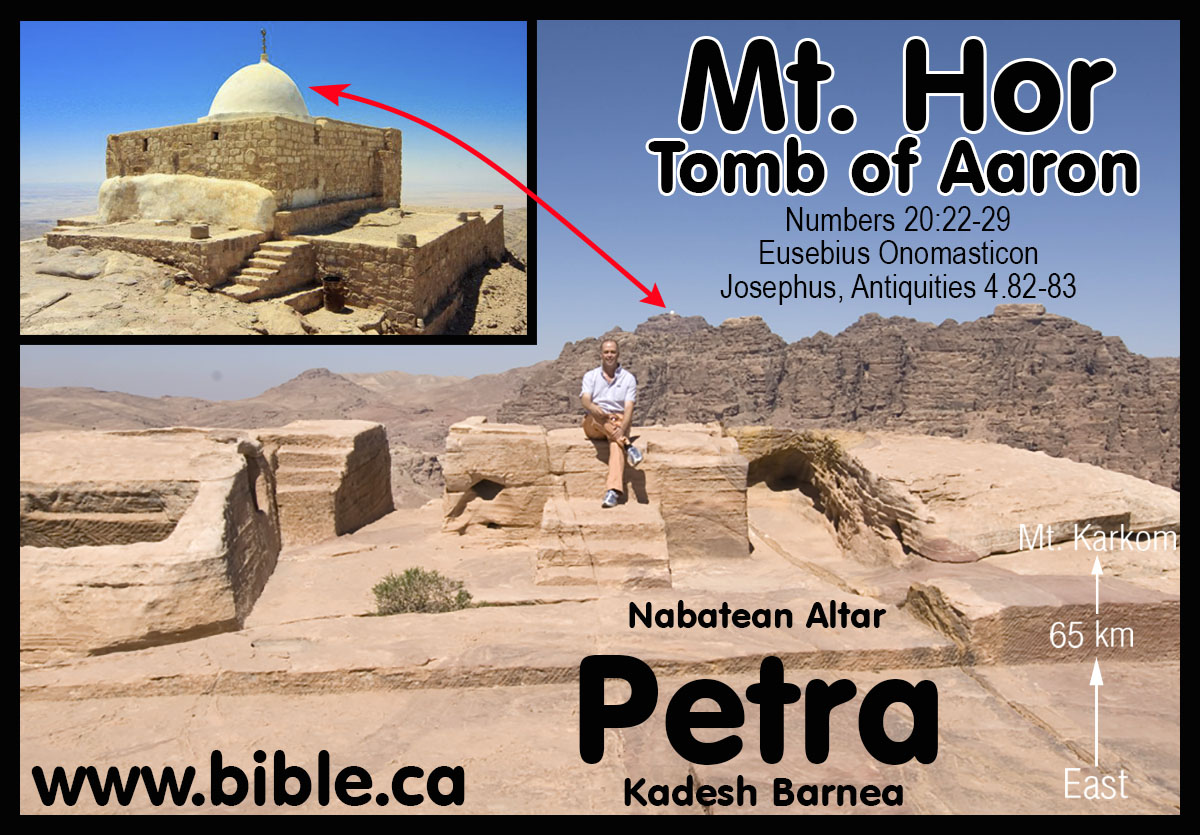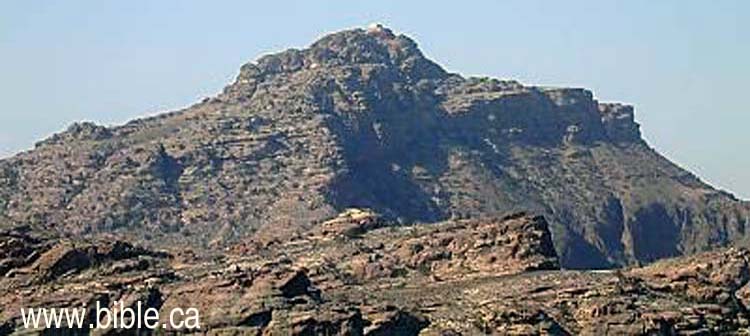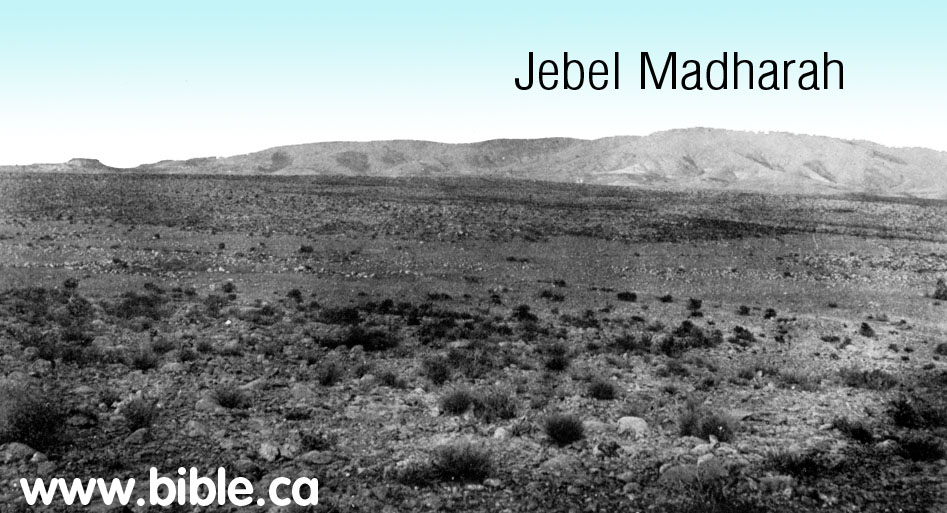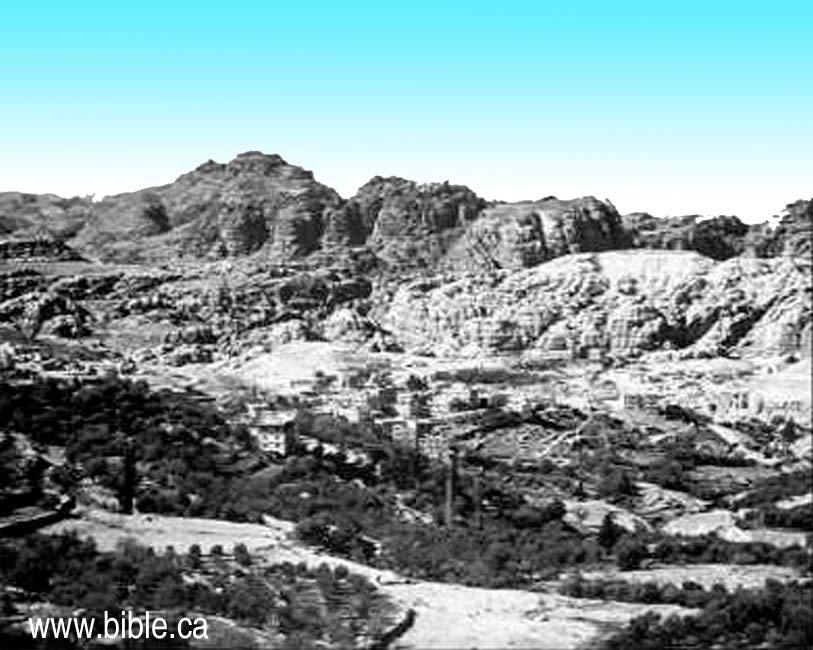Mt. Hor, Moserah: Aaron's Mountain (Jebel Haroun) at Petra
Burial place of Aaron during the Exodus
Introduction:
- Mt. Hor was only "one stop" from Kadesh: Numbers 20:22
- Both Kadesh and Mt. Hor were on the border of Edom: Numbers 33:37
- Josephus and Eusebius that "Jebel Haroun" at Petra was Mt. Hor.
- Jebel Haroun: Literally, "the Mountain of Aaron"
- When John Lewis Burckhardt discovered Petra in 1812 AD, he began to hear local Bedouin tales of a magnificent city carved ages ago out of solid rock by magicians working for the Egyptian pharaoh. The city was located in the vicinity of the Tomb of Aaron and a valley called the River of Moses
A. History of the search for Mt. Hor:
|
The little white dome on the top of the summit is the Tomb of Aaran of Mt. Hor at Petra. |
- The oldest historical record we have regarding the location of Mt. Hor is by Josephus, who located it at Petra.
- Maps up until 1831 AD located Both Kadesh Barnea and Mt. Hor at or near Petra.
- However, between 1831 and 1916 AD, the location for Kadesh and Mt. Hor were moved from Petra to four places: In 1831, Karl Von Raumer chose Ein Hasb for Kadesh Barnea. In 1838 Edward Robinson chose Ein El Weibeh. just a few km south of Ein Hasb. Between 1881-1916 AD, Kadesh was located at Ein Qedeis. Between 1916 -2005 AD Kadesh was thought to be at Ein el-Qudeirat. Since 2005 AD, Kadesh has been stored back to the Petra area.
- As a result of moving Kadesh, there was a necessity to move Mt. Hor, since they are only one stop apart in the exodus route.
- Between 1881 to the present time, Jebel Maderah has been the choice for Mt. Hor by those who believe Kadesh is at Ein el-Qudeirat.
B. 1881 - 1916 AD Mt. Hor located at Jebel Maderah: (also spelled Madherah)
- In 1884 AD, Henry Trumbull popularized the idea that Kadesh was not at Petra, as had been believed for 2000 years before him, but at Qedeis. He comments on how there is a need to redefine the land of Edom in a new way. He suggests that Edom was not limited to the transjordan, but right beside Kades in the land of Judah: " "This identification, with its linkings, necessitates the re-shaping of much of the geography of the southern border of Palestine and the neighboring regions, as indicated in the maps, cyclopedias, commentaries, and guide-books, now in common use. For example, as the westernmost limit of Edom is not indicated in the Bible except by its relation to Kadesh-barnea, that limit now passes from an unknown to a known quantity, by the fixing of a site which is described as just beyond it. So, also, the traditional Mount Hor must be recognized as an impossible Mount Hor; and the central and northern Arabah must no longer be counted a main camping-ground of the Israelites in their wanderings." (Kadesh-Barnea, Henry Clay Trumbull, 1884 AD, p 320)
- In 1884 AD, Henry Trumbull chose Jebel Madurah as Mt. Hor: "Yet, all this while, there is a mountain which fully meets the requirements of the Bible text, and the rational demands of the narrative, as to the Mount Hor where Aaron died and was buried. That mountain is Jebel Madurah, near the western extremity of "Wady Feqreh, a little to the southwest of the passes Es-Sufuh and El-Yemen" (Kadesh-Barnea, Henry Clay Trumbull, 1884 AD, p 320)
- In 1908 AD, George L. Robinson believed Kadesh was at Ein Qedeis (Kades) and rejected Mt. Hor at Petra in favour of "Jebel Madherah", which is just north-east of Kades.
- George L. Robinson gives his reasons why he rejects Mt. Hor at Petra: "The modem Arabs, however, do not claim that Aaron died here. The sheikh who for nearly forty years has acted as custodian of the sacred mosque which adorns the summit of Jebel Haroun frankly concedes that the "prophet" Aaron did not die here but at Ein El Weibeh near which there is a Kabr, or tomb, where he was buried originally. Later, they say, his body was carried to `Ain Melfha- a fountain one day's journey southwest of Petra near Wady Jeraifeh- and finally, it "flew" to its present resting-place in the cave under the modem mosque on Jebel Haroun. The story is obviously worthless." (The True Mount Hor, Jebel Maderah. George L. Robinson, The Biblical World, Vol. 31, No. 2., Feb., 1908, p 86-100)
- "The location of Jebel Maderah with reference to Kadesh corresponds most perfectly with the statement in Num. ao: 16, that Kadesh is "a city in the uttermost of Edom's border." Jebel Maderah lies northeast of ' Ain Kadess, and therefore on the route which would naturally be followed in marching direct from Kadesh across Edom to Moab. Jebel Haroun on the other hand is too distant from Kadesh to satisfy the Biblical description." (The True Mount Hor, Jebel Maderah. George L. Robinson, The Biblical World, Vol. 31, No. 2., Feb., 1908, p 86-100)
- In 1908 AD, George L. Robinson believed Kadesh was located at Ein Qedeis and Mt. Hor at Jebel Madharah just north of Kadess, he write this about Mt. Hor at Petra: "Jebel Haroun is located about three miles west of Petra, and is one of the most conspicuous peaks in the Mt. Seir range. It rises precipitously from the arid plain of the `Arabah to a height of 4,500 feet. Seven hours are required to ascend it. The rocks are of richly variegated sandstone and very beautiful. The view from the roof of the little white mosque which crowns the summit of the mountain is among the finest rock scenery in the world. On every side there is a maze of mountains, cliffs, and chasms. Far across the `Arabah in the west rise the comparatively low mountains of the wilderness. In the distant north glisten the waters of the Dead Sea. The oasis of green about Ein El Weibeh. relieves to some degree the barrenness of the `Arabah. Eagles, hawks, and vultures of various sorts fly screaming overhead." (The True Mount Hor, Jebel Maderah. George L. Robinson, The Biblical World, Vol. 31, No. 2., Feb., 1908, p 86-100)
- In 1910 AD, Nathan Schmidt was the lone voice that believed Kadesh and Mt. Hor was at Petra: "On the other hand, the association of the Siq at Petra and its wonderful stream of limpid water with Moses, and the sacred mountain with Aaron, does not seem to have originated either with Christians or Muhammadans. When Eusebius declares that "even at the present time there is shown the rock struck by Moses " near the city of Petra (Onom. ed. Klostermann, p. 176, 1. 8), he may have heard this from Christians. But they, no doubt, drew upon Jewish traditions, for Josephus knew of Moses' presence in Petra (Anti. iv. 4. 7), and clearly identified Mt. Hor with Jebel Haran. All the references to this mountain as the place of Aaron's death belong to post-exilic additions to the Pentateuch, and there is no reason whatever to doubt that the mountain near Petra is everywhere meant. It is conceivable that the occupation of the Negeb by the Edomites made the Judeans reluctant to admit that some such shrines as the tomb of Aaron and the place where Moses gave his oracles were within the new territory of Edom, and preferred to think of them as in Mt. Seir, now wrested from the hostile brother nation by the Nabateeans. Was there an early tradition that warranted this feeling ? While the Judean kingdom held control over the cities of the Negeb, there can be no doubt that the death of Aaron was connected with Moserah (the "smooth " mountain, Jebel Madharah), and the piercing of the rock with Kadesh Barnea (El 'Ain or 'Ain Kdes). But the possession of Mt. Seir itself by David, Solomon for a short time at least, and Amaziah may have given vogue to a rival theory inspired by the more majestic scenery of Petra. It seems to me even more probable that Petra was the original scene of these stories. Here the great Deliverer (Cp. my article "The Jerahmeel Theory and the Historic Importance of the Negeb," Hibbert Journal, vi. 2 January, 1908, pp 339ff.) performed the miracle of piercing the rock and sending the wonderful stream through the Sik, and here his older brother Aaron died on the peak of Mt. Hor. In earlier times the gulf of 'Akabah reached farther north than it does to-day, and a passage from the eastern side over to El Tih may not have been as easy as it is at present. Nomadic tribes pushing northwest from the land of Midian no doubt found their way down into the Negeb through the defiles of Mt. Seir (Jebel Sharra). The Idumaean clans that camped around Moserah and Zin probably brought with them the traditions of their heroes. Their way from Sinai-Horeb to Kadesh Barnea and Mt. Halak is likely to have led them through the Valley of Moses and put the reputed resting-place of Aaron in Petra." (Kadesh Barnea, Nathan Schmidt, Journal of Biblical Literature, Vol 29, no 1, 1910 AD, p75-76)
- In 1910 AD, Nathan Schmidt gave his reasons for rejecting Jebel Madharah and agreeing with Josephus and Eusebius that Mt. Hor was at Petra. Schmidt said that Jebel Madharah was not Mt. Hor, but "Smooth Mountain" of Joshua 11:17; 12:7: Mount Halak: "I climbed Jebel Madharah on the 20th of June, 1905. (Compare the accompanying photograph.) Neither guides familiar with the country nor natives of that region knew apparently of any Kades in that neighborhood. I can see no insurmountable linguistic difficulty in identifying the mountain with the Moserah of Deut. 10:6, nor any improbability in the view that tradition at one time placed the death of Aaron on its summit, while an earlier tradition located it on Jebel Haron. It seems to me quite certain that Jebel Madharah is the ... of Josh. 11:17. It was called the " smooth" or " slippery " mountain because of the shaly stone that breaks under one's feet, and renders the ascent difficult and the descent only too easy." (Kadesh Barnea, Nathan Schmidt, Journal of Biblical Literature, Vol 29, no 1, 1910 AD, p73)
- In 1910 AD, Nathan Schmidt chose Mt. Hor at Petra: "But they, no doubt, drew upon Jewish traditions, for Josephus knew of Moses' presence in Petra (Ant. iv. 4. 7), and clearly identified Mt. Hor with Jebel Haroun. All the references to this mountain as the place of Aaron's death belong to post-exilic additions to the Pentateuch, and there is no reason whatever to doubt that the mountain near Petra is everywhere meant." (Kadesh Barnea, Nathan Schmidt, Journal of Biblical Literature, Vol 29, no 1, 1910 AD, p73)
C. What the Bible says about Mt. Hor:
|
Mt. Hor at Petra |
- Death of Aaron: "Then the Lord spoke to Moses and Aaron at Mount Hor by the border of the land of Edom, saying, "Aaron will be gathered to his people; for he shall not enter the land which I have given to the sons of Israel, because you rebelled against My command at the waters of Meribah. "Take Aaron and his son Eleazar and bring them up to Mount Hor; and strip Aaron of his garments and put them on his son Eleazar. So Aaron will be gathered to his people, and will die there." So Moses did just as the Lord had commanded, and they went up to Mount Hor in the sight of all the congregation. After Moses had stripped Aaron of his garments and put them on his son Eleazar, Aaron died there on the mountain top. Then Moses and Eleazar came down from the mountain. When all the congregation saw that Aaron had died, all the house of Israel wept for Aaron thirty days." Numbers 20:23-29
- "Then they set out from Mount Hor by the way of the Red Sea, to go around the land of Edom; and the people became impatient because of the journey." Numbers 21:4
- "They journeyed from Bene-jaakan and camped at Hor-haggidgad. They journeyed from Hor-haggidgad and camped at Jotbathah." Numbers 33:32-33
- "They journeyed from Kadesh and camped at Mount Hor, at the edge of the land of Edom. Then Aaron the priest went up to Mount Hor at the command of the Lord, and died there in the fortieth year after the sons of Israel had come from the land of Egypt, on the first day in the fifth month. Aaron was one hundred twenty-three years old when he died on Mount Hor." Numbers 33:37-39
- "Then they journeyed from Mount Hor and camped at Zalmonah." Numbers 33:41
- "'And this shall be your north border: you shall draw your border line from the Great Sea to Mount Hor. You shall draw a line from Mount Hor to the Lebo-hamath, and the termination of the border shall be at Zedad" Numbers 34:7-8
- "Then die on the mountain where you ascend, and be gathered to your people, as Aaron your brother died on Mount Hor and was gathered to his people," Deuteronomy 32:50
D. Where did Aaron Die?
- Although the Bible is clear that Aaron died on Mt. Hor, Deut 10:6 seems to say that Aaron died at "Moserah": "Now the sons of Israel set out from Beeroth Bene-jaakan to Moserah. There Aaron died and there he was buried and Eleazar his son ministered as priest in his place. From there they set out to Gudgodah, and from Gudgodah to Jotbathah, a land of brooks of water." Deuteronomy 10:6-7
- There is a difference in the itinerary between Deut 10 and Num 33 because order of the stops seems to be reversed. This kind of reversal is common in the synoptic gospels and does not represent a contradiction. Often the timing and sequence of actual events is arranged differently depending upon the purpose of the narrative. Acts 10 and 11 tell the same story but in very different order. Here the Holy Spirit told us that the Chapter 11 narrative by Peter is in fact the correct: "But Peter began speaking and proceeded to explain to them in orderly sequence, saying," Acts 11:4
- "The most reasonable way to understand the Numbers and Deuteronomy passages is to assume that Deuteronomy, unlike Numbers, is not in the form of a technical itinerary and therefore is to be seen as a mere listing of sites of significance without any necessary attention to spatial or even chronological sequence. In other words, the purpose of the passage is not to dictate one's understanding of its geographical data. Moses was content to mention places that bore out his contention that Israel's history had been one of constant covenant defection." (The New American Commentary, Deut 10:6)
- It may be that Moserah is the district and Mt. Hor is the specific mountain.
Conclusion:
- The oldest tradition that Mt. Hor is a Petra dates back to Josephus and Eusebius.
- In 1881 AD Mt. Maderah was proposed as Mt. Hor, only because they had decided that Kadesh was not at Petra, but at Kades, then later Qudeirat.
- We know from the Bible that Kadesh must be located transjordan, therefore Mt. Hor at Petra is the only choice.
By Steve Rudd: Contact the author for comments, input or corrections.




